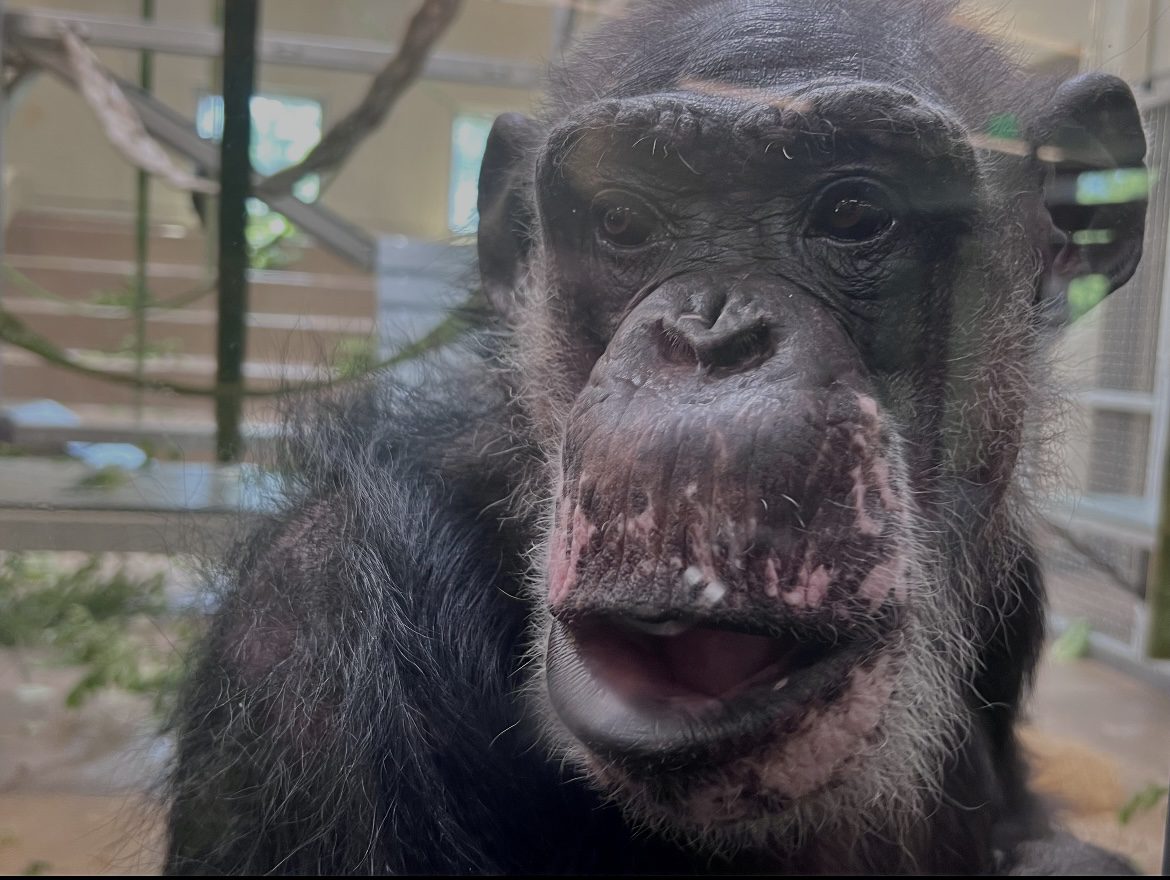Ever wanted to see chimpanzees play on touchscreens or ogle at your shoes?
At the Indianapolis Zoo, the chimps now have an interactive way to greet guests — if they choose to do so.
Thanks to an elevated steel highway, and tempered glass, chimps can roam as they please, and even get up close to guests.

The three exhibits — a community hub, a cognition center and a culture center — connected by a highway, make up the Indianapolis Zoo’s new Penny & Jock Fortune International Chimpanzee Complex presented by Central Indiana Honda Dealers.
The complex, which is the largest exhibit to open at the zoo since 2014, emulates the chimp’s natural environment, said Dr. Robert Shumaker, president and CEO of the zoo.
“(Chimps) need the opportunity to spread out and decide when they want to be together or not, so that facilitates the kind of social relationships we’re interested in.” Shumaker said.
Chimps climb and socialize
Zoo visitors can see these social behaviors as soon as they enter the zoo.
Outside of the zoo’s front gate is the community hub, an outdoor area that includes a lofty, rust-colored climbing structure and two sheltered areas.

In addition to giving chimps new spots to socialize, the new complex is part of chimpanzee conservation efforts to preserve the endangered species.
But that’s not all. Shumaker thinks the complex will also better the chimp’s mental health.
“Apes can go through life events that are very difficult or could be very depressing for them,” Shumaker said. “Our job is to make sure they’re super resilient and super socialized. So just like in humans, if you go through a difficult event in your life, you have enough other social resources to help guide you through it in a way that’s positive.”
This “social resource” is a new one. According to Dr. Chris Martin, director of research at the zoo, only about a handful of the chimps have been in a zoo before. Yet, the chimps seem comfortable in their new environment. Many seem to like making friends, climbing new structures, and knuckle-walking across the zoo as visitors do the same on foot below.
Are you smarter than a chimpanzee?
Besides climbing at the community hub, chimpanzees can take the elevated trail to the Harlan/Shriver Families Cognition Center, the second of the complex’s locations, where the chimps can test their problem-solving skills by playing various games — like tic-tac-toe — on touchscreens.

“These serve a few different functions,” Martin said. “One is to give the ape something enriching and fun to do, another reason is to see how intelligent the apes are, if people can see them doing these elaborate tasks. And the third reason is we’re doing science. We’re giving them tasks that are designed to probe how they think.”
Martin noted that so far, a lot of the apes seem to be thinking with their stomachs, playing the games to win tasty treats the stations dispense when they win.
Apes aren’t the only ones in for a treat at the cognition station. Visitors will be able to play the same games the chimpanzees play on touchscreens of their own and see how they compare.
Have chimps check your shoes
In addition to the games, visitors interested in seeing an up close and personal view of the chimps can visit the Deborah J. Simon Culture Center.
Here, some chimps point out visitors to look at their shoes. Others like checking out pictures people take of them.

These interactions aren’t the only purpose of the center. Tim Littig, lead curator of primates, said it is the place to go to watch chimps use makeshift tools and congregate.
“Chimpanzees have really complex social structures,” Littig said. “One of the ways they make friends … is with grooming each other, which is social currency for a chimpanzee.”
Because of the new exhibit, chimps are having no trouble making friends.
“We’ve been able to really witness that over time, even individuals that didn’t know each other before they got to the zoo have now started to form relationships with each other,” said Beth Kosiba, zoo interpretations manager.
But fun interactions aren’t all Kosiba wants visitors to get from seeing the complex.
“I hope that they develop an appreciation for chimpanzees as a species,” Kosiba said. “It’s really important to conserve not just one population of chimpanzees, but all of the populations because they all have kind of these unique cultures.”
The complex opened to the public on May 25. Zoo employees recommend that visitors come at cooler times, earlier or later in the day, to see the chimps at peak activity.
The Zoo, located at 200 W. Washington St. Indianapolis, is open from 9 a.m. to 4 p.m. from Monday through Thursday, and 9 a.m. to 5 p.m. from Friday to Sunday.
Contact Indianapolis Recorder Intern Kayla Barlow at kaylab@indyrecorder.com.
For more news from the Indianapolis Recorder, visit our homepage.






